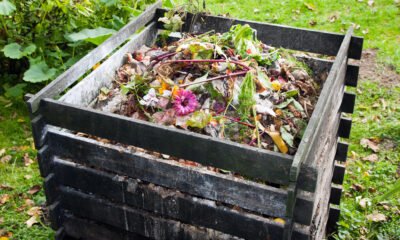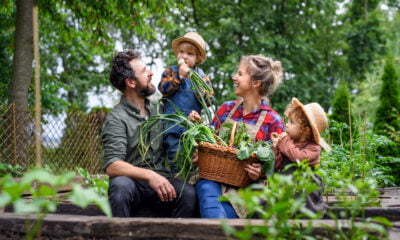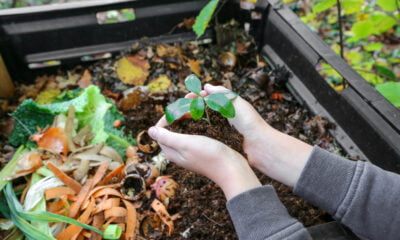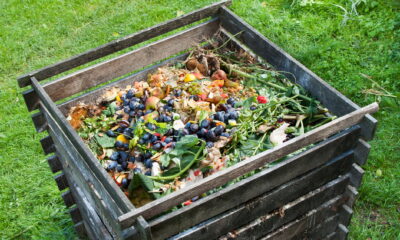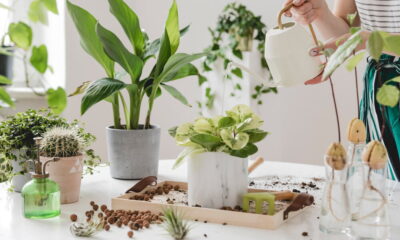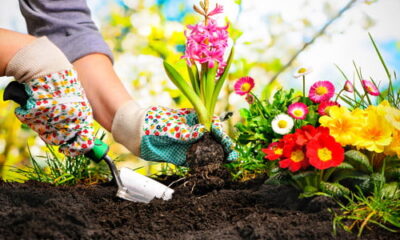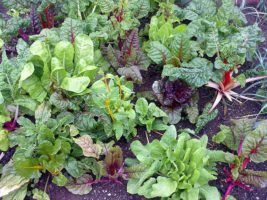

Environment
Create a More Sustainable Garden and Get Started with Composting
One of the most important things you can do for your garden is to feed it nutrient-rich compost. While a mixture of grass clippings, leaves and vegetable matter may not sound exciting, it can do amazing things when it comes to improving your soil structure and providing your plants with the nutrients they need to thrive.
You can easily create your own compost for little or no cost, in your own backyard or on your patio. However, it’s important that you start composting now because it can take about a year for the compost to be ready to use in your garden. If you’re ready to get started, here are some steps you can take that can help you compost at home.
Choose a Container
There are a number of containers made for compost. You’ll find some at your local garden center. You can purchase a sealed bin that has a small door where you add the organic matter. You might also consider buying a composting barrel on a stand that allows you to tumble it – CompostBinHQ has a good selection of all sorts.
If you’re a traditionalist you won’t need to buy a container, you can create a conventional compost heap. You build a four-sided box from scrap lumber and place it in a corner of your backyard, according to Nicholas Staddon, director of new plants for Monrovia. The company grows 22 million plants (and over 2,300 varieties) annually. You want to position the compost heap away from your home and outdoor gathering places because the compost can get stinky when it’s not in a sealed container.
Start Piling
If you want to have an organic garden, make sure you only put organic items in your compost. According to Robert McLaughlin, CEO of Organic Bouquet in Maitland, Florida, you should not add chemically-treated produce in your compost or you’ll be adding those chemicals. The majority of your compost should be fruit and vegetables. However, you can add small sticks, straw, grass clippings, paper and newspaper. Staddon says that the amount of chemicals in a newspaper is so small that it does not make a big difference.
If you run short of organic matter, ask your neighbors for their vegetable waste or grass clippings. According to Staddon, you’d be doing them a favor. If your neighbor owns goats, chickens or horses, you may also be able to get nutrient-packed manure.
Hit the Right Ratio
When adding to your compost heap, you want to make sure you keep a healthy ratio of nitrogen-rich matter and carbon-rich matter, according to Nell Foster, gardening blogger, horticulturist and owner of Joy Us in Santa Barbara, California, which creates eco-conscious garden accessories. A healthy ratio is 25 to 30 parts carbon to one-part nitrogen. If you can maintain this ratio, it is the quickest way to produce aromatic, fertile compost. If the mix has too much carbon decomposition will slow down. If the nitrogen levels are too high, then you’ll have a smelly pile.
Finely shredded cardboard, straw, leaves, sawdust, ashes, corn stalks, peanut shells, pine needles and fruit are excellent sources of carbon. Coffee grounds, garden waste, manure, hay, seaweed, grass clippings, clover and vegetable scraps have high levels of nitrogen. According to Foster, you should do a little research before throwing things into your compost pile. And make sure the plant matter, you throw into the pile has not gone to seed or they can take root in your compost. For example, if you toss your rotting jack-o-lantern in the compost, you may find your pile full of sprouting pumpkin plants.
Stir Your Compost Regularly
Turn the compost heap regularly with a garden fork to aerate the soil. This will help to speed up the bacterial activity. You can tell when a compost is ready by its appearance. When ready the compost will have the look of rich, healthy soil.
Keep the Compost Warm
Compost breaks down faster when kept warm, so it’s important to keep your compost bin or heap insulated from the cold. That’s the reason many compost bin containers are black, to attract the sun. Covering a heap with a black tarp can have the same effect. The ideal temperature for your compost heap is 140 to 160 degrees Fahrenheit. Although you want to try to keep the temperature at that level, don’t worry if it drops. The microbes in the compost can generate their own heat, so some decomposition will occur, as long as the compost heap is above freezing. Here are some tips to keep compost warm during winter.
Collect the Run-off
Some compost bins allow rainwater to flow through. The water comes out of the bottom of the bin and collects for drainage. This liquid is an amazing fertilizer; all you need to do is pour it around the plants in your garden.
Put the Compost to Work
When the compost is ready, add it to your garden. After the plants in your garden have taken root and have 10 to 12-inches of growth, you can add an inch of compost on top of the soil. McLaughlin advises you to blend the compost into the soil for the best results.

